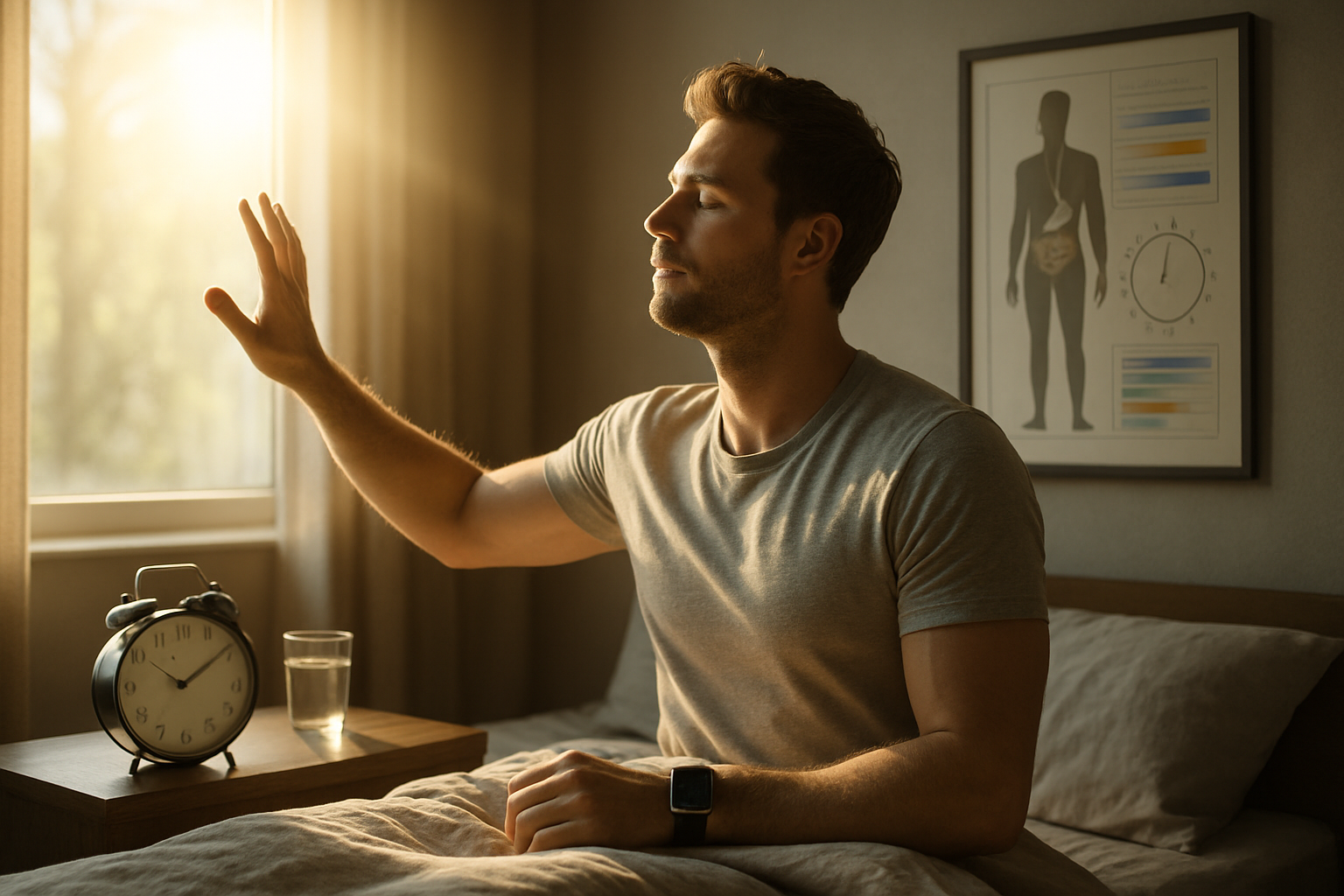Biohacking Your Circadian Rhythm: The Science of Light Therapy
Imagine waking up each morning feeling refreshed, energized, and ready to conquer the day. Now, picture maintaining that vitality throughout your waking hours, seamlessly transitioning into a restful sleep at night. Is this level of well-being achievable through something as simple as light? Recent scientific advancements suggest that the answer is a resounding yes.

The Circadian Connection
Our bodies operate on a 24-hour cycle known as the circadian rhythm. This internal clock regulates various physiological processes, including hormone production, body temperature, and sleep-wake cycles. At the heart of this system is the suprachiasmatic nucleus (SCN), a tiny region in the brain that acts as our master timekeeper.
Light plays a crucial role in synchronizing our circadian rhythm with the external environment. When light enters our eyes, it stimulates specialized photoreceptors called intrinsically photosensitive retinal ganglion cells (ipRGCs). These cells send signals directly to the SCN, influencing the production of melatonin, the hormone responsible for regulating our sleep-wake cycle.
The Science Behind Light Therapy
Light therapy, also known as phototherapy, involves exposure to specific wavelengths of light at particular times of the day to modulate our circadian rhythm. While natural sunlight remains the gold standard, artificial light sources can be used to similar effect, especially in regions with limited daylight hours or for individuals with irregular schedules.
Research has shown that blue light wavelengths (460-480 nm) are particularly effective at suppressing melatonin production and increasing alertness. Conversely, warmer, amber-colored light (580-600 nm) has less impact on melatonin levels, making it ideal for evening use.
Applications and Benefits
The applications of light therapy extend far beyond treating seasonal affective disorder (SAD), its most well-known use. Recent studies have explored its potential in various areas of health and wellness:
-
Mood Enhancement: Exposure to bright light in the morning has been shown to increase serotonin levels, potentially alleviating symptoms of depression and anxiety.
-
Cognitive Performance: Research suggests that blue-enriched light can improve alertness, reaction time, and cognitive function, particularly during the afternoon slump.
-
Sleep Quality: By aligning light exposure with our natural circadian rhythm, we can improve sleep onset, duration, and overall quality.
-
Jet Lag Management: Strategic light exposure can help travelers adjust to new time zones more quickly, minimizing the effects of jet lag.
-
Shift Work Adaptation: Light therapy can assist night shift workers in maintaining alertness during work hours and adjusting their sleep schedule on days off.
Implementing Light Therapy in Daily Life
Incorporating light therapy into your routine doesn’t necessarily require expensive equipment. Here are some practical ways to leverage the power of light:
-
Morning Light Exposure: Aim for 20-30 minutes of bright light exposure within the first hour of waking. Natural sunlight is ideal, but light therapy devices can be effective alternatives.
-
Blue Light Management: Use blue light-blocking glasses or apps in the evening to minimize melatonin suppression and promote better sleep.
-
Strategic Light Breaks: Take short breaks during the day to expose yourself to bright light, especially if you work in a dimly lit environment.
-
Warm Lighting in the Evening: Switch to warm, amber-colored lighting in the hours leading up to bedtime to support natural melatonin production.
-
Light-Based Alarm Clocks: Consider using a sunrise alarm clock that gradually increases light intensity to wake you up more naturally.
Potential Risks and Considerations
While light therapy is generally considered safe, it’s important to be aware of potential risks and contraindications. Some individuals may experience headaches, eye strain, or sleep disturbances when first starting light therapy. Those with certain eye conditions or taking photosensitizing medications should consult with a healthcare professional before beginning treatment.
Moreover, the timing of light exposure is crucial. Misaligned light therapy can potentially disrupt circadian rhythms rather than optimize them. It’s essential to work with a knowledgeable practitioner or follow evidence-based guidelines when implementing a light therapy regimen.
Illuminating Facts: Shedding Light on Wellness
-
The human eye can detect a single photon of light in complete darkness.
-
Exposure to morning sunlight can help regulate appetite hormones, potentially aiding in weight management.
-
Blue light exposure during the day can improve reaction times by up to 26%.
-
The color temperature of light is measured in Kelvins (K), with higher values corresponding to cooler, bluer light.
-
Light therapy has shown promise in treating non-seasonal depression, with some studies reporting efficacy comparable to antidepressant medication.
As we continue to unravel the intricate relationship between light and our biology, the potential for light therapy to enhance our health and well-being becomes increasingly clear. By understanding and leveraging the power of light, we can take a significant step towards optimizing our circadian rhythms and, by extension, our overall health. As with any wellness strategy, personalization and consistency are key. By mindfully incorporating light therapy into our daily routines, we open the door to a brighter, more balanced, and energized life.





